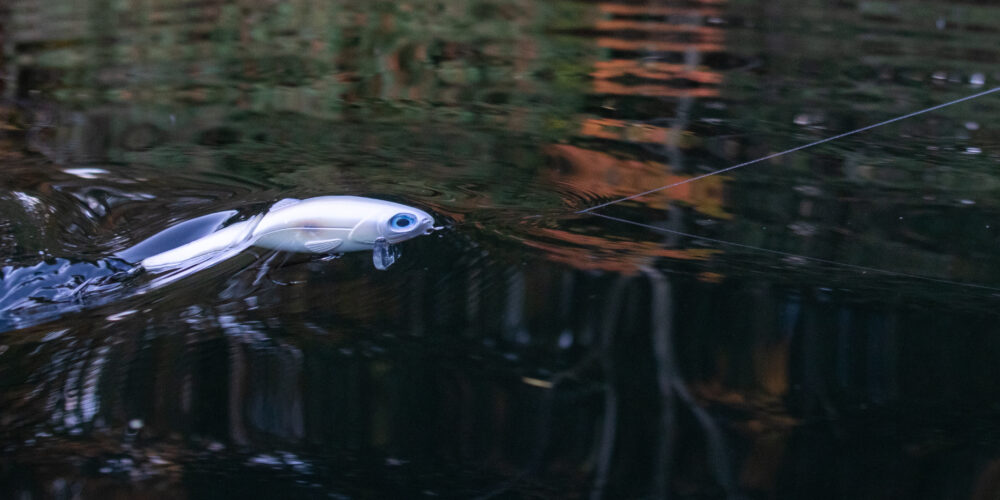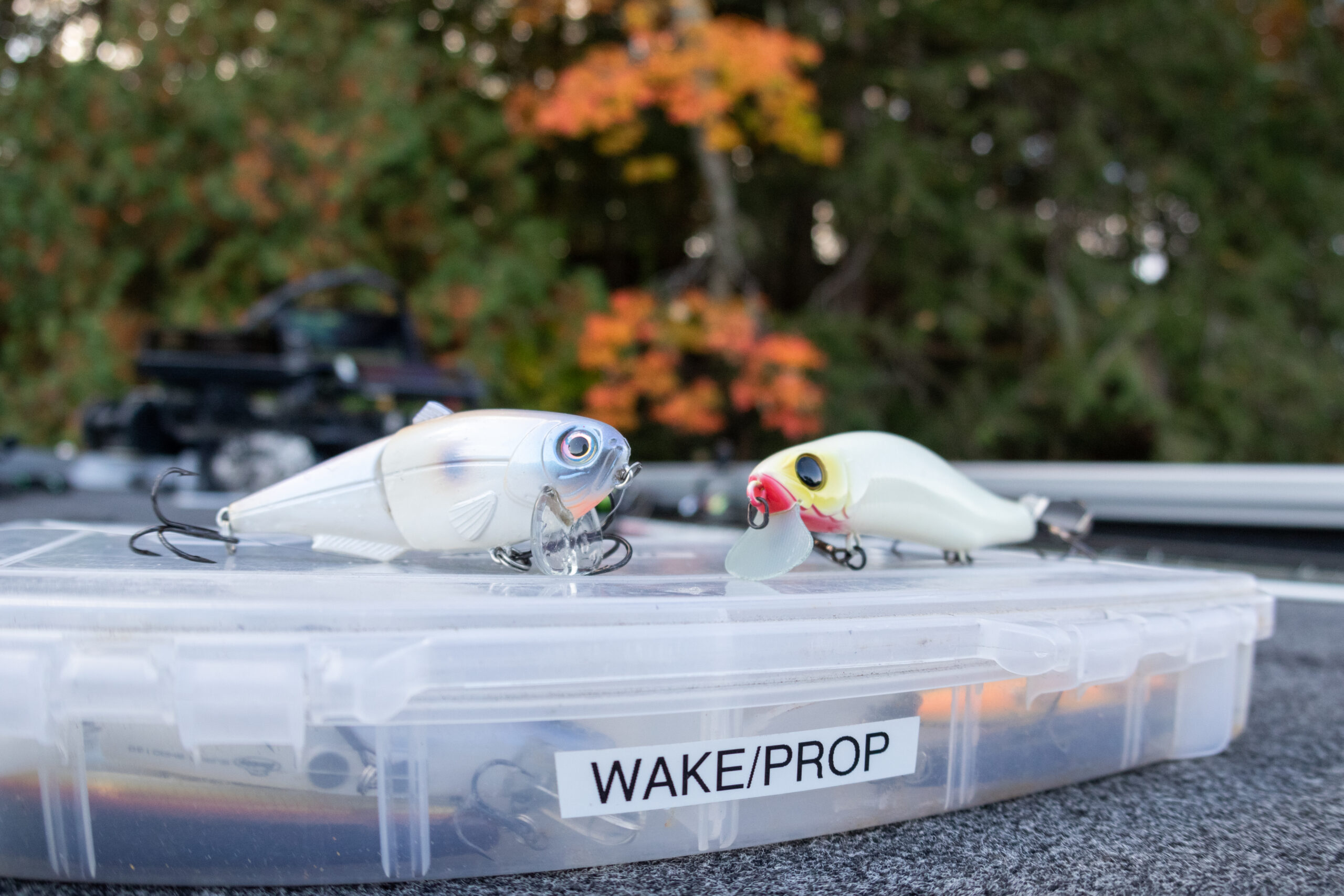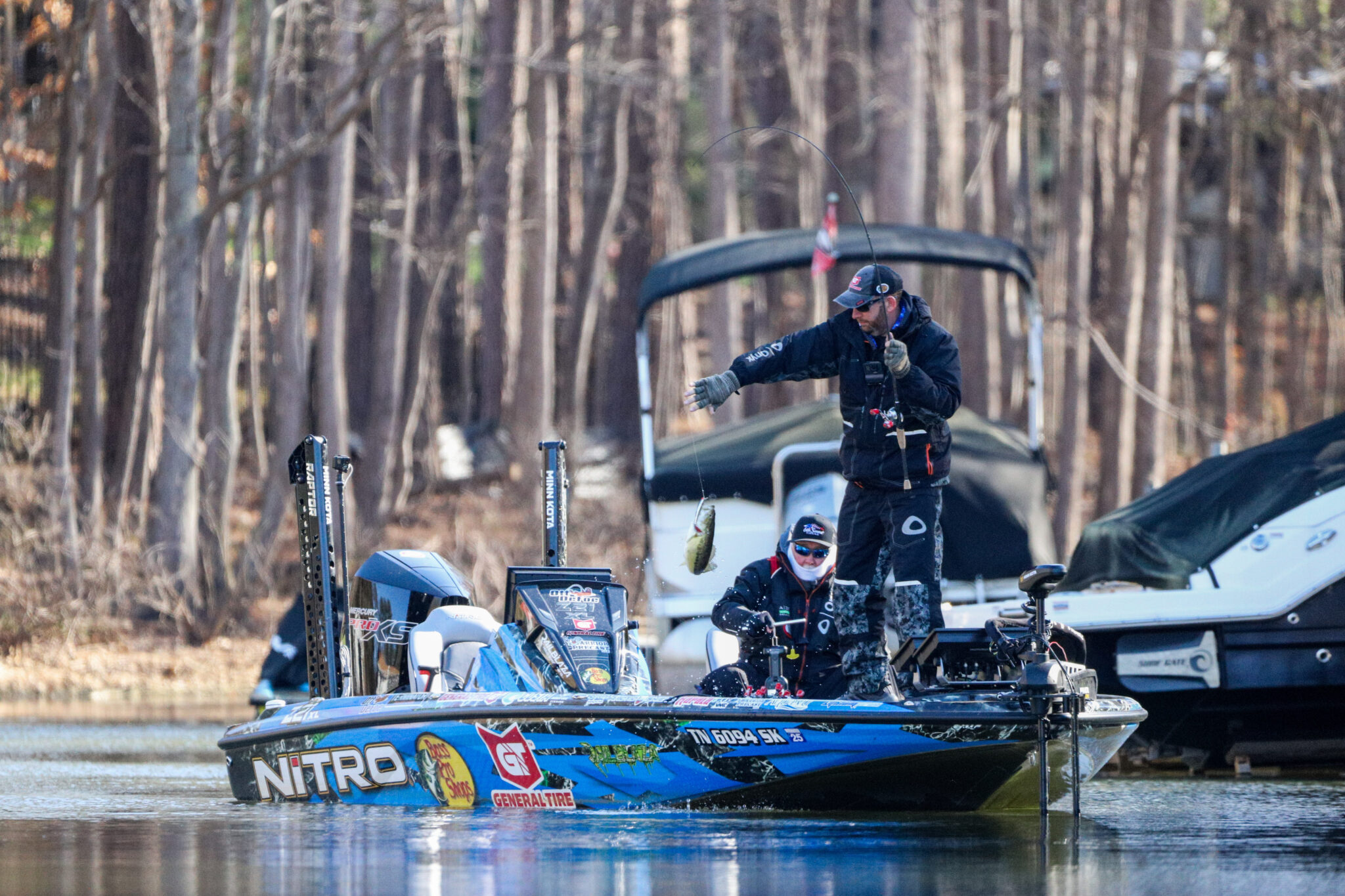Wake up to the power of wakebaits
Mercury pros DeFoe, Suggs lean on a lesser-used topwater option in the fall (and beyond!)

Everyone loves a topwater bite, and for most anglers, now is the best time of the year to chase those heart-stopping blow ups. But when everyone on your lake is beating the banks with walking baits, buzzbaits and frogs, bass can grow wary of them in a hurry.
That’s just one reason Mercury Pro Team angler Ott DeFoe believes a wakebait is an under-utilized tool. He uses it not only to show bass something different during the fall months, but in spring and summer, as well. DeFoe caught keepers on a wakebait during three of the eight BPT events he fished in 2023 on his way to yet another top-five finish in the Angler of the Year standings.
“It’s one of the easiest topwater baits to fish, and it’s one of the less-fished ones,” DeFoe said. “A wakebait is certainly easier than a walking bait, but it seems like a lot of people categorize it differently; almost think of it as a swimbait or something. I don’t know if they’re intimidated by it or what, but it can be a very easy bait to fish.”
On one hand, DeFoe is correct; presenting a lure doesn’t get much easier than casting out a wakebait and reeling it back to the boat. But implementing wakebaits into your topwater arsenal can, indeed, feel intimidating. It’s a confusing lure category that necessitates finely tuned gear, and not many pros have shed light on when, exactly, they shine.
Until now. DeFoe and fellow Mercury pro Scott Suggs explained why you should start throwing wakebaits and spilled the juice on what types, when and where to pick them up.

Picking the right gear
Just about any bait can technically be waked. It’s not uncommon to see anglers fish a spinnerbait so that the blades bulge the surface. Same goes for swim jigs and soft plastic swimbaits around shallow vegetation. However, when anglers say they’re throwing a wakebait, they’re usually referring to one of four lure types, each of which are specifically designed to create that V-shape on the surface.
There are crankbaits that run at or just beneath the top of the water column, like the old-school Mann’s 1-minus or the more modern Strike King 2.5 Wakebait. There are minnow-shaped plugs, like the Cotton Cordell Red Fin. There are jointed, hard swimbaits with bills that cause them to run along the surface, ranging from smaller sizes, such as the discontinued Strike King Wake Shad, to the 8-inch, $75-plus River2Sea Tactical Wake 210. Finally, a growing number of wakebaits imitate land-dwelling animals, like the rat DeFoe threw during his second-place finish at Lake Murray in April (more on that later).
DeFoe does the majority of his waking with a minnow-style bait. Suggs generally opts for the Wake Shad, especially during the postspawn. When he wants a smaller offering, as is often the case in the fall, he’ll switch to the Strike King Wakebait.
“In the fall, they’re normally feeding on a lot smaller bait,” Suggs said, “and that waking crankbait style just always seems to be better for me in the fall, especially over shallow, submerged grass and stuff like that.”

Regardless of what type of wakebait they’re throwing, both DeFoe and Suggs said one key is finding a bait that swims smoothly and creates a wake at their desired speed. For years, Suggs said, he had to tinker with his wakebaits to get them to run properly when retrieved quickly. One reason he loves the Wake Shad is because it has the swimming action he’s looking for right out of the package, regardless of speed. He called it “idiot-proof.”
“Once the Strike King Wake Shad came out, that bait was just so stupid, so easy,” the Arkansas pro said. “It’s shaped more like a shad body, and it was just, right out of the package, just absolutely perfect, the way it ran and everything.”
It’s not just picking the right wakebait that can be daunting. Selecting the rod, reel and line to throw it can also be intimidating. Anglers need to be able to make long casts and keep the bait on the surface while also having enough forgiveness in their setup that they aren’t constantly pulling the treble hooks out of fish’s mouths.
DeFoe and Suggs achieve that balance in different ways. DeFoe throws his wakebaits on a 6-foot-8, medium-power rod that he says has some give to it — the same rod he uses for walking topwaters and poppers. Suggs, meanwhile, uses a 7-1, medium-heavy rod. But while DeFoe uses braided line (typically 30-pound test), Suggs always throws his wakebaits on monofilament. He usually opts for 14-pound mono but will upsize to 17-pound around heavy cover.
“I don’t want anything sinking in front of it,” Suggs said. “On a wakebait, it’s always monofilament. I’m always throwing a 7-foot-1, somewhere in there, medium-heavy action rod. … And then in the fall, I’ll usually throw a little bit softer rod, more of a medium-action rod, when I’m fishing over shallow grass and stuff with it. But when I get around those boat docks, there’s a lot of times I’ll go back to a little heavier rod, like a medium-heavy or something pretty close to it, because of all the cables and the poles and everything else, so if I get him on, I can get him out.”
A three-season search bait
Want to give wakebaits a try? Now is the perfect time. Given that imitating baitfish and covering water are two major keys to fall fishing, it’s no surprise that both DeFoe and Suggs mentioned autumn as one of their favorite seasons to employ the technique.
DeFoe throws a wakebait in typical fall locations. He targets bluff ends early in the season and transitions to flats as the temperature continues to drop, with the presence of baitfish being key. Wakebaits are ideally suited for the latter scenario because they can be fished extremely shallow but are more subtle than, say, plopper-style baits.
Suggs likes to use wakebaits around shallow cover during fall. That could be boat docks or shallow grass that isn’t quite topped out. His two tips for doing so: match the size of the baitfish and elicit reaction strikes by bumping the cover with the bait.
“I’ll vary it from a small one to a little bigger one until I can figure out which one they really want,” he said. “Something that I can bounce off of those floats and everything on the boat dock.”

Even as winter arrives and water temperatures become too cold to throw topwaters, don’t despair. You won’t have to wait long before eliciting another blow up — and a wakebait will probably be your best bet to do so.
One of DeFoe’s favorite times to throw a wakebait is during prespawn. As water temperatures rise into the 50s, fish tend to suspend closer to the surface, he explained. When the prespawn jerkbait bite fizzles but before fish start showing up on beds, he picks up a wakebait. The bait’s combination of subtle action with significant drawing power makes it an ideal prespawn weapon, as DeFoe proved when he caught several keepers on a wakebait during his 10th-place finish at REDCREST 2023 on Lake Norman.
“It’s gotta be a slow-moving (bait), but truly steady,” he said. “You’re like, well, throw a popper out there, that’s a really slow-moving topwater. But I don’t think it has the drawing power that that slow, meandering wake does. A popper just sitting there, far enough away from them, I don’t think they really care, where that wakebait is kind of constantly moving and doing its thing, they draw to it a little bit more.”
A wakebait should continue to have a spot on your deck during and after the spawn. It’s a perfect bait for triggering strikes from bass guarding fry, Suggs said. It can also be a cure for those pesky spring cruisers, as DeFoe found during Stage Three at Lake Murray. Throughout the tournament, he could see wolf packs of big bass swimming in the shallows but struggled to get them to bite. During the Championship Round, he finally tried a rat, which he borrowed from another competitor. The first fish he fooled with it, a 5-pounder, vaulted him into second place in the final standings. He’s since returned that rat, but bought a handful of his own.
“I was like, man, these are big fish, it would be good if I had some type of a really big bait that I felt like I could actually target these with,” DeFoe said. “I didn’t want a glide bait — I knew they had seen a lot of glide baits. … A wakebait was what I had in mind. And I thought I had something in the truck. I didn’t. It was a really big, minnow-style wakebait. And then that kind of just got my wheels to turning, and a rat was the next thing that came to mind. That 5-pounder I caught that day was the first fish I had ever caught on one.”
Even as bass move deeper following the spawn, DeFoe and Suggs continue to rely on wakebaits. Suggs’ favorite time of year to throw the bait occurs when postspawn fish first school up offshore, as was the case when he rode the bait to a Top-10 finish at a BPT event on Table Rock Lake in 2019. Like many anglers, Suggs believes the best way to trigger the biggest bass in those schools is with a large topwater. But when others opt for walking baits, he throws the Wake Shad, especially if the water surface is fairly flat.
“You can just sit there and make multiple casts and catch them over and over,” Suggs said. “For whatever reason, they get wise to that walking bait fast.”
Suggs will keep the bait in his hands all day during early summer, too. Even though high, sunny skies typically push bass lower in the water column, those conditions allow the fish to see his wakebait from further away. Using his Lowrance ActiveTarget, he’s observed fish charge from as deep as 20 feet to hit it in clear water. DeFoe experienced a similar phenomenon at Lake St. Clair this year. During his first day of qualifying, he caught several keeper smallmouth using a wakebait.
“I got to playing with a wakebait in a swimming pool on a sunny day, and it is amazing when that thing’s waking at the shadow that it puts off,” Suggs said. “You can watch the bottom of the pool, never look at the bait, watch the bottom of the pool and tell exactly where that bait’s at, what it’s doing and everything. That shadow goes past them and automatically they know where that shadow’s coming from, and they’re looking straight up, they’re coming.”